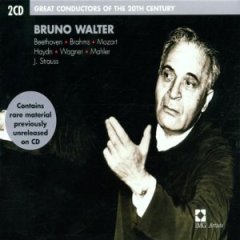Great Conductors of the 20th Century Vol.15 - Bruno Walter
Great Conductors of the 20th Century Vol.15 - Bruno Walter

CD1 Beethoven - Symphony No. 6 In F 'Pastoral' Op. 68 (Awakening of Cheerful Feelings On Arriving In the Country) 1. I. Allegro Ma Non Troppo 2. II. Andante Molto Moto 3. III.Allegro 4. IV.Allegro 5. V.Allegretto Brahms - Symphony No. 2 In D Op. 73 6. I.Allegro Non Troppo 7. II.Adagio Non Troppo 8. III.Allegretto Grazioso 9. IV.Allegro Con Spirito Wiener Philharmoniker (1-5) New York Philharmonic Orchestra (6-9) CD2 1. Mozart Le nozze di Figaro, K 492 Overture Haydn - Symphony No. 92 In G, 'Oxford' 2. I.Adagio 3. II.Adagio 4. III.Menuet 5. IV.Presto 6. Wagner Die Meistersinger von Nurnberg Act 1 Prelude 7. Wagner Die Walkure Act 2, Scene 5 8. Mahler Kindertotenlieder Nun will die Sonn' so hell aufgeh'n 9. Mahler Symphony no 5 in C sharp minor 4th movement, Adagietto 10. Johann-Strauss Die Fledermaus Overture British Symphony Orchestra (1,6) Orchestre de la Société des Concerts du Conservatoire (2-5, 10) Wiener Philharmoniker (7-9) Bruno Walter - conductor
These days Bruno Walter is best known for his Columbia Symphony stereo recordings, most of which were made when he was in his 80s and in poor health. By that time warm mellowness often replaced his earlier, more energetic interpretive stance. Such generalizations can be overdone though, as evidenced by his 1936 Vienna Philharmonic recording of Beethoven’s Sixth Symphony on this two-disc Bruno Walter entry in EMI’s Great Conductors of the 20th Century series. It’s a fine performance, but aside from a somewhat brisker country stroll at its opening and slightly more precise articulation throughout, it’s not radically different from his familiar Columbia Symphony stereo recording on Sony made 22 years later. In this Beethoven, the first of Walter’s three recordings of the work, he is slightly more inclined to expressive rubatos and encourages discreet touches of portamento in the strings. But the biggest difference lies in the two decades of engineering advancements that make his Sony recording the preferred one and this early one a document of interest to Walter fans and conductor buffs.
The Beethoven shares a disc with Brahms’ Symphony No. 2, made in 1953 with the New York Philharmonic. This is another duplication of Walter’s Sony stereo repertoire, but in vibrant mono sound that conveys the energetic drive of the finale and the cushioned warmth of his lyrical slow movement. The New Yorkers always played well for Walter and here they play with sustained tension, riveting wind solos, powerfully pungent brass, and the strings’ perfect combination of toughness and warmth. Walter’s Brahms particularly excelled in the naturalness of transitions. With many conductors, not excepting Toscanini, there’s often a feeling of lurching from one section to another, all the stitches showing in the seams; with Walter, such transitions are effected with a graceful ease that redirects attention to the musical content and not to how it gets there.
Disc 2 is more of a potpourri, an inevitable consequence of trying to encompass the long recording career and wide musical sympathies of a great conductor. The major work is Haydn’s Symphony No. 92, made in 1938 with the Paris Conservatory Orchestra. Walter had just fled the Nazi takeover in Vienna, his daughter was imprisoned, and he faced an uncertain future as a refugee. Yet he captures all of Haydn’s joy and wit in a reading that balances drive and elegance. The outer movements sweep along with speedy liveliness, the minuet dances, and the Adagio has both grace and gravity. Mozart is represented by a breakneck Figaro Overture; Wagner by a broad Meistersinger Act 1 Prelude and part of Scene 5 from Act 2 of Die Walküre featuring Lotte Lehmann’s intense Sieglinde. Walter’s bond to Vienna is recognized by Johann Strauss’ Fledermaus Overture in which the conductor gets his Parisian band to deliver a bubbly, echt-Viennese performance.
If Walter was identified with any composer it was with Mahler, who’s represented here by two selections. The first is “Nun will die Sonn’ so hell aufgeh’n” from Kindertotenlieder in the classic, heart-rending Kathleen Ferrier recording with the Vienna Philharmonic in 1949. The other, from January, 1938 with a very different pre-war Vienna orchestra, is a flowing Adagietto from the Fifth Symphony clocking in at 8 minutes, faster than later norms but no less gorgeous for its lack of excess.
While the recordings in this Great Conductors entry were made between 1930 (the Meistersinger Prelude) and 1953 (Brahms’ Second) they’re hardly “early” in the context of Walter’s career. He was 54 in 1930, 77 in 1953. So these represent Walter in his mature prime. The earliest recordings betray compressed dynamics, but the 1936 Beethoven, while sharing those deficits, has a warm, full sound and the Brahms is a well-recorded example of late monophonic engineering. ---Dan Davis, classicstoday.com
download:








